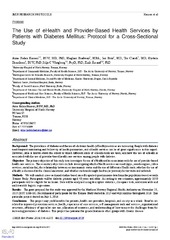| dc.contributor.author | Dudarev, Alexy A. | |
| dc.contributor.author | Odland, Jon Øyvind | |
| dc.date.accessioned | 2014-03-24T09:02:55Z | |
| dc.date.available | 2014-03-24T09:02:55Z | |
| dc.date.issued | 2013 | |
| dc.description.abstract | Background. There is a paradox in Russia and its Arctic regions which reports extremely low rates of
occupational diseases (ODs), far below those of other socially and economically advanced circumpolar
countries. Yet, there is widespread disregard for occupational health regulations and neglect of basic
occupational health services across many industrial enterprises.
Study design and methods. This review article presents official statistics and summarises the results of a search
of peer-reviewed scientific literature published in Russia on ODs and occupational health care in Russia and
the Russian Arctic, within the period 1980 2010.
Results. Worsening of the economic situation, layoff of workers, threat of unemployment and increased work
load happened during the ‘‘wild market’’ industrial restructuring in 1990 2000, when the health and safety of
workers were of little concern. Russian employers are not legally held accountable for neglecting safety rules
and for underreporting of ODs. Almost 80% of all Russian industrial enterprises are considered dangerous or
hazardous for health. Hygienic control of working conditions was minimised or excluded in the majority of
enterprises, and the health status of workers remains largely unknown. There is direct evidence of general
degradation of the occupational health care system in Russia. The real levels of ODs in Russia are estimated
to be at least 10 100 times higher than reported by official statistics. The low official rates are the result of
deliberate hiding of ODs, lack of coverage of working personnel by properly conducted medical examinations,
incompetent management and the poor quality of staff, facilities and equipment.
Conclusions. Reform of the Russian occupational health care system is urgently needed, including the passing
of strong occupational health legislation and their enforcement, the maintenance of credible health
monitoring and effective health services for workers, improved training of occupational health personnel,
protection of sanitary-hygienic laboratories in industrial enterprises, and support for research assessing
occupational risk and the effectiveness of interventions. | en |
| dc.identifier.citation | International Journal of Circumpolar Health 72(2013) s. - | en |
| dc.identifier.citation | International Journal of Circumpolar Health (2013), vol 72:20456 | en |
| dc.identifier.cristinID | FRIDAID 1075974 | |
| dc.identifier.doi | http://dx.doi.org/10.3402/ijch.v72i0.20456 | |
| dc.identifier.issn | 1239-9736 | |
| dc.identifier.uri | https://hdl.handle.net/10037/6081 | |
| dc.identifier.urn | URN:NBN:no-uit_munin_5773 | |
| dc.language.iso | eng | en |
| dc.publisher | CoAction Publishing | en |
| dc.rights.accessRights | openAccess | |
| dc.subject | VDP::Medical disciplines: 700::Health sciences: 800::Health service and health administration research: 806 | en |
| dc.subject | VDP::Medisinske Fag: 700::Helsefag: 800::Helsetjeneste- og helseadministrasjonsforskning: 806 | en |
| dc.subject | VDP::Medical disciplines: 700::Health sciences: 800::Occupational health: 809 | en |
| dc.subject | VDP::Medisinske Fag: 700::Helsefag: 800::Yrkesmedisin: 809 | en |
| dc.title | Occupational health and health care in Russia and Russian Arctic: 1980–2010 | en |
| dc.type | Journal article | en |
| dc.type | Tidsskriftartikkel | en |
| dc.type | Peer reviewed | en |


 English
English norsk
norsk


